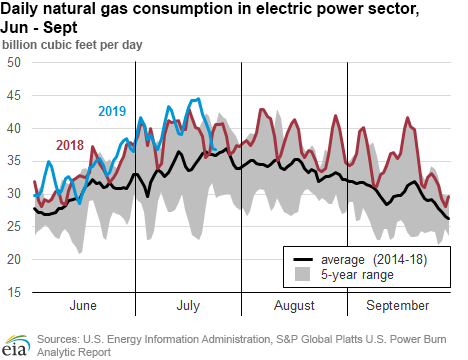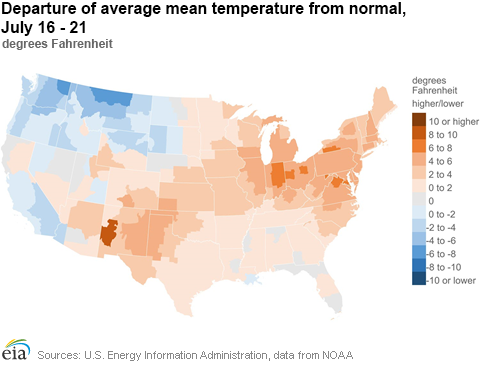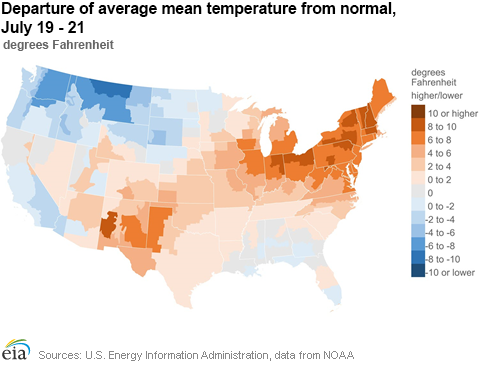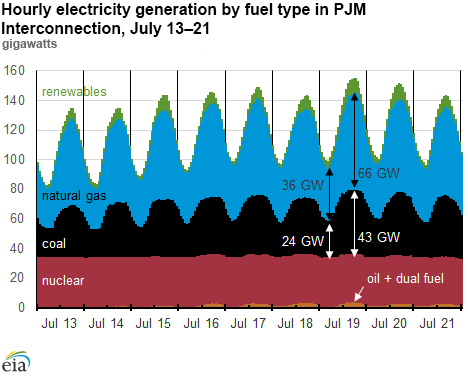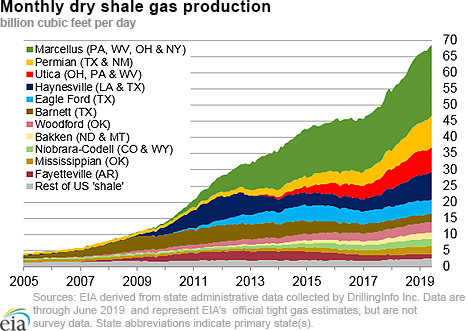In the News:
United States sets new daily record-high for power burn
The United States set a new record for natural gas consumption by electric power plants (power burn) of 44.5 billion cubic feet per day (Bcf/d) on Friday, July 19, according to S&P Global Platts. Since July 1, 2019, U.S. power burn has exceeded the previous record of 43.1 Bcf/d―set on July 16, 2018―on five days: July 10 and July 16–19. Much higher-than-normal temperatures, structural changes to the power sector (particularly in the Northeast), and low natural gas prices all contributed to increased natural gas consumption by electric generators.
Higher electricity demand for space cooling in the past week was the main driver of increased natural gas-fired power generation as a record-setting heat wave affected much of the Lower 48 states. Although the hottest temperatures occurred over the weekend, most states east of the Rocky Mountains experienced warmer-than-normal weather in the days leading up to the heat wave. From July 16–21, the average maximum temperature exceeded 85 degrees Fahrenheit (°F) in most parts of the country; furthermore, average minimum temperatures, particularly in the Midwest and Northeast, were 8°F–10°F higher than average, resulting in increased cooling demand during off-peak periods.
Another contributing factor to the record power burn was relatively low natural gas prices, which averaged $2.33 per million British thermal units (MMBtu) from July 16–21 at the Henry Hub in Louisiana, according to Natural Gas Intelligence. So far this summer, Henry Hub prices have averaged $2.34/MMBtu, 19% lower than during the same period last year. Although the Henry Hub price represents regional prices along the Gulf Coast and in Southeast markets, natural gas in the Midwest and Northeast markets typically trades at a discount to Henry Hub during summer months. This summer, spot natural gas prices at the Chicago Citygate—the regional price benchmark for Midwestern states—have averaged 19¢/MMBtu lower than Henry Hub prices, and regional spot prices in the Northeast (e.g., Dominion South) have traded 30¢/MMBtu lower than Henry Hub.
Structural changes to the electric power sector also contributed to record-breaking natural gas-fired generation this summer, particularly in the PJM Interconnection, the regional transmission organization (RTO) responsible for managing wholesale electricity in 13 states and the District of Columbia. Approximately 12 gigawatts (GW) of new natural gas-fired electric generation capacity―primarily highly efficient combined-cycle units―have entered service in PJM since January 2018, increasing total natural gas-fired capacity by 18%. As a result, during periods of increased demand, natural gas-fired plants have been dispatched at higher levels than in previous years. On July 19, when natural gas consumption reached its highest level last week, PJM dispatched 66 GW of natural gas-fired generators at the point of peak demand during the day, 30 GW more than its base level in the early morning. In comparison, only 43 GW of coal-fired generation capacity, which was the second-highest fuel source on that day, was dispatched at its highest point.
Overview:
(For the week ending Wednesday, July 24, 2019)
- Natural gas spot prices fell at most locations this report week (Wednesday, July 17, to Wednesday, July 24). Henry Hub spot prices fell from $2.38/MMBtu last Wednesday to $2.22/MMBtu yesterday.
- At the New York Mercantile Exchange (Nymex), the price of the August 2019 contract decreased 8¢, from $2.304/MMBtu last Wednesday to $2.220/MMBtu yesterday. The price of the 12-month strip averaging August 2019 through July 2020 futures contracts declined 7¢/MMBtu to $2.394/MMBtu.
- Net injections to working gas totaled 36 Bcf for the week ending July 19. Working natural gas stocks are 2,569 Bcf, which is 13% more than the year-ago level and 6% lower than the five-year (2014–18) average for this week.
- The natural gas plant liquids composite price at Mont Belvieu, Texas, fell by 21¢/MMBtu, averaging $4.53/MMBtu for the week ending July 24. The price of butane, natural gasoline, isobutane, ethane, and propane all fell by 10%, 9%, 6%, 1%, and 1%, respectively.
- According to Baker Hughes, for the week ending Tuesday, July 16, the natural gas rig count increased by 2 to 174. The number of oil-directed rigs fell by 5 to 779. The total rig count decreased by 4, and it now stands at 954.
Prices/Supply/Demand:
Prices are down at Henry Hub and most trading points. This report week (Wednesday, July 17, to Wednesday, July 24), temperatures were higher than normal across the Northeast and Great Lakes regions after a heatwave at the beginning of the week. By the end of the report week, most of the strong heat began to taper off, putting downward pressure on prices. Temperatures across the eastern and central United States were generally lower than normal by the end of the report week. Henry Hub spot prices fell 16¢ from $2.38/MMBtu last Wednesday to a low of $2.22/MMBtu yesterday. At the Chicago Citygate, prices decreased 25¢ from $2.26/MMBtu last Wednesday to a low of $2.01/MMBtu yesterday.
California prices rise. Steady cooling demand strengthened prices as temperatures across most of California averaged 75–80°F during the report week. Prices at PG&E Citygate in Northern California rose 9¢, up from $2.69/MMBtu last Wednesday to $2.78/MMBtu yesterday. Prices at SoCal Citygate increased 89¢ from $2.69/MMBtu last Wednesday to $3.58/MMBtu yesterday. Southern California continues to experience supply constraints, keeping pressure on prices. On Tuesday, the California Public Utilities Commission (CPUC) issued a new withdrawal protocol for Aliso Canyon, allowing withdrawals in emergencies to meet electricity demand.
Northeast prices decline. At the Algonquin Citygate, which serves Boston-area consumers, prices went down 28¢ from $2.35/MMBtu last Wednesday to a low of $2.07/MMBtu yesterday. At the Transcontinental Pipeline Zone 6 trading point for New York City, prices decreased 32¢ from $2.41/MMBtu last Wednesday to $2.09/MMBtu yesterday.
Tennessee Zone 4 Marcellus spot prices decreased 18¢ from $2.10/MMBtu last Wednesday to $1.92/MMBtu yesterday. Prices at Dominion South in southwest Pennsylvania fell 19¢ from $2.14/MMBtu last Wednesday to $1.95/MMBtu yesterday.
Permian Basin prices increase. Prices at the Waha Hub in West Texas, which is located near Permian Basin production activities, averaged $0.78/MMBtu last Wednesday, $1.60/MMBtu lower than Henry Hub prices. Yesterday, prices at the Waha Hub averaged $0.86/MMBtu, $1.36/MMBtu lower than Henry Hub prices. Prices have increased throughout the week with the announcement that Kinder Morgan’s Gulf Coast Express pipeline was linepacking—injecting natural gas into all pressurized sections of the pipeline—according to Genscape. The 2.0 Bcf/d pipeline is expected to be in service ahead of its anticipated completion date of October 2019 and will bring Permian supply to Gulf Coast and Mexican demand markets.
Supply rises. According to data from PointLogic Energy, the average total supply of natural gas rose by 1% compared with the previous report week. Dry natural gas production grew by 1% compared with the previous report week. Average net imports from Canada decreased by 4% from last week.
Demand is flat. Total U.S. consumption of natural gas was unchanged from the previous report week, averaging 68.3 Bcf/d according to data from PointLogic Energy. Natural gas consumed for power generation declined by 2% week over week despite reaching a record high on Friday. Industrial sector consumption increased by 4% week over week. In the residential and commercial sectors, consumption declined by 2%. Natural gas exports to Mexico decreased 1%.
U.S. liquefied natural gas (LNG) exports increase week over week. Ten LNG vessels (seven from Sabine Pass, one from Cove Point, one from Corpus Christi, and one from Cameron) with a combined LNG-carrying capacity of 37 Bcf departed the United States between July 18 and July 24, according to shipping data compiled by Bloomberg. One vessel was loading at the Sabine Pass terminal on Wednesday.
Freeport LNG export terminal, located in Quintana Island, Texas, has received an authorization from the Federal Energy Regulatory Commission to introduce hazardous fluids for Train 1 as part of the commissioning activities. The EPC contractor of the facility—Chiyoda, McDermott, and Zachry Group—announced on July 23 that feedgas has been introduced to Train 1 as part of the final commissioning of the train. Freeport LNG is a three-train facility, with a combined LNG-export capacity of 2 Bcf/d. Train 1 is scheduled to come online in September 2019, and the remaining two trains are scheduled to come online in the second and third quarters of 2020. The fourth train at the facility has been fully approved, but it is not yet under construction.
Storage:
Net injections into storage totaled 36 Bcf for the week ending July 19, compared with the five-year (2014–18) average net injections of 44 Bcf and last year's net injections of 27 Bcf during the same week. Working gas stocks totaled 2,569 Bcf, which is 151 Bcf lower than the five-year average and 300 Bcf more than last year at this time.
According to The Desk survey of natural gas analysts, estimates of the weekly net change from working natural gas stocks ranged from net injections of 29 Bcf to 48 Bcf, with a median estimate of 35 Bcf.
The average rate of net injections into storage is 32% higher than the five-year average so far in the refill season (April through October). If the rate of injections into storage matched the five-year average of 9.3 Bcf/d for the remainder of the refill season, total inventories would be 3,541 Bcf on October 31, which is 151 Bcf lower than the five-year average of 3,692 Bcf for that time of year.
More storage data and analysis can be found on the Natural Gas Storage Dashboard and the Weekly Natural Gas Storage Report.
See also:
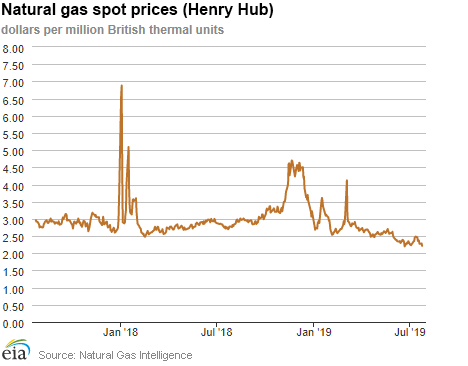
| Spot Prices ($/MMBtu) | Thu, 18-Jul |
Fri, 19-Jul |
Mon, 22-Jul |
Tue, 23-Jul |
Wed, 24-Jul |
|---|---|---|---|---|---|
| Henry Hub |
2.36 |
2.28 |
2.28 |
2.29 |
2.22 |
| New York |
2.44 |
2.27 |
2.07 |
2.03 |
2.09 |
| Chicago |
2.23 |
2.11 |
2.06 |
2.05 |
2.01 |
| Cal. Comp. Avg.* |
2.39 |
2.17 |
2.78 |
2.76 |
2.76 |
| Futures ($/MMBtu) | |||||
| August contract | 2.287 |
2.251 |
2.312 |
2.300 |
2.220 |
| September contract |
2.263 |
2.228 |
2.293 |
2.275 |
2.202 |
| *Avg. of NGI's reported prices for: Malin, PG&E Citygate, and Southern California Border Avg. | |||||
| Sources: Natural Gas Intelligence and CME Group as compiled by Bloomberg, L.P. | |||||
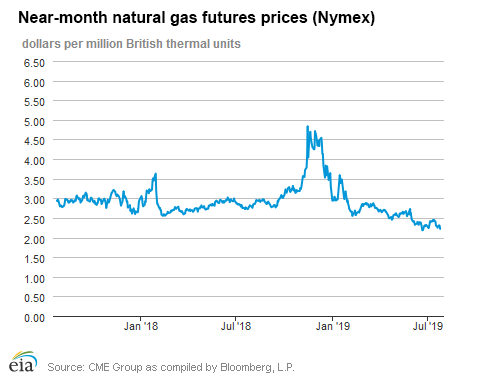
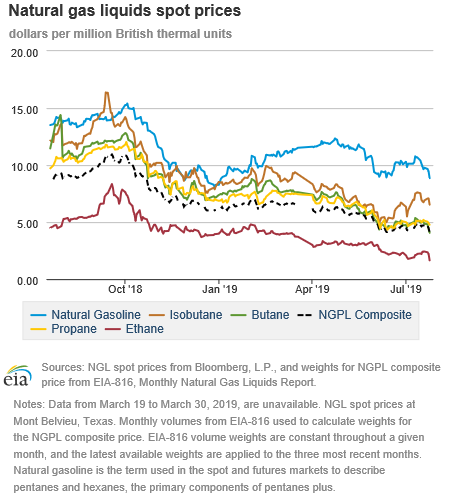
| U.S. natural gas supply - Gas Week: (7/18/19 - 7/24/19) | |||
|---|---|---|---|
Average daily values (Bcf/d): |
|||
this week |
last week |
last year |
|
| Marketed production | 100.1 |
99.3 |
93.4 |
| Dry production | 89.5 |
88.8 |
82.7 |
| Net Canada imports | 5.1 |
5.3 |
5.8 |
| LNG pipeline deliveries | 0.1 |
0.1 |
0.1 |
| Total supply | 94.7 |
94.1 |
88.6 |
|
Source: OPIS PointLogic Energy, an IHS Company | |||
| U.S. natural gas consumption - Gas Week: (7/18/19 - 7/24/19) | |||
|---|---|---|---|
Average daily values (Bcf/d): |
|||
this week |
last week |
last year |
|
| U.S. consumption | 68.3 |
68.3 |
68.8 |
| Power | 40.3 |
41.0 |
39.6 |
| Industrial | 20.5 |
19.7 |
21.3 |
| Residential/commercial | 7.5 |
7.7 |
8.0 |
| Mexico exports | 4.9 |
5.0 |
4.6 |
| Pipeline fuel use/losses | 6.2 |
6.1 |
5.9 |
| LNG pipeline receipts | 6.1 |
5.8 |
3.4 |
| Total demand | 85.4 |
85.2 |
82.7 |
|
Source: OPIS PointLogic Energy, an IHS Company | |||
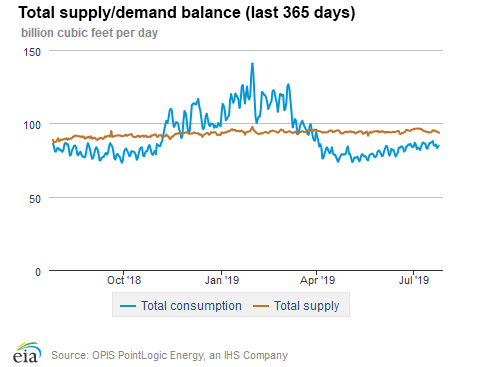
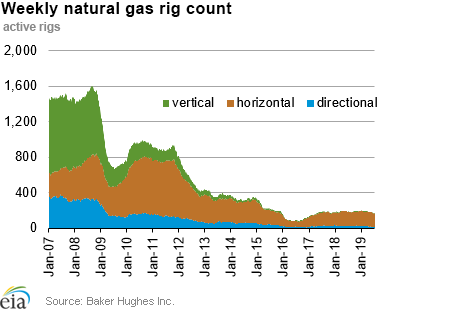
| Rigs | |||
|---|---|---|---|
Tue, July 16, 2019 |
Change from |
||
last week |
last year |
||
| Oil rigs | 779 |
-0.6% |
-9.2% |
| Natural gas rigs | 174 |
1.2% |
-7.0% |
| Note: Excludes any miscellaneous rigs | |||
| Rig numbers by type | |||
|---|---|---|---|
Tue, July 16, 2019 |
Change from |
||
last week |
last year |
||
| Vertical | 1 |
0.0% |
0.0% |
| Horizontal | 17 |
6.3% |
-29.2% |
| Directional | 69 |
-1.4% |
3.0% |
| Source: Baker Hughes Inc. | |||
| Working gas in underground storage | ||||
|---|---|---|---|---|
Stocks billion cubic feet (Bcf) |
||||
| Region | 2019-07-19 |
2019-07-12 |
change |
|
| East | 575 |
561 |
14 |
|
| Midwest | 650 |
627 |
23 |
|
| Mountain | 151 |
147 |
4 |
|
| Pacific | 271 |
268 |
3 |
|
| South Central | 921 |
929 |
-8 |
|
| Total | 2,569 |
2,533 |
36 |
|
|
Source: Form EIA-912, Weekly Underground Natural Gas Storage Report | ||||
| Working gas in underground storage | |||||
|---|---|---|---|---|---|
Historical comparisons |
|||||
Year ago (7/19/18) |
5-year average (2014-2018) |
||||
| Region | Stocks (Bcf) |
% change |
Stocks (Bcf) |
% change |
|
| East | 524 |
9.7 |
604 |
-4.8 |
|
| Midwest | 522 |
24.5 |
656 |
-0.9 |
|
| Mountain | 145 |
4.1 |
172 |
-12.2 |
|
| Pacific | 256 |
5.9 |
294 |
-7.8 |
|
| South Central | 823 |
11.9 |
994 |
-7.3 |
|
| Total | 2,269 |
13.2 |
2,720 |
-5.6 |
|
| Source: Form EIA-912, Weekly Underground Natural Gas Storage Report | |||||
| Temperature – heating & cooling degree days (week ending Jul 18) | ||||||||
|---|---|---|---|---|---|---|---|---|
HDD deviation from: |
CDD deviation from: |
|||||||
| Region | HDD Current |
normal |
last year |
CDD Current |
normal |
last year |
||
| New England | 0 |
-1 |
0 |
64 |
22 |
12 |
||
| Middle Atlantic | 0 |
-1 |
0 |
78 |
21 |
5 |
||
| E N Central | 0 |
-1 |
-1 |
81 |
24 |
9 |
||
| W N Central | 0 |
-3 |
0 |
88 |
17 |
1 |
||
| South Atlantic | 0 |
0 |
0 |
119 |
22 |
13 |
||
| E S Central | 0 |
0 |
0 |
102 |
8 |
-5 |
||
| W S Central | 0 |
0 |
0 |
128 |
4 |
-12 |
||
| Mountain | 0 |
-4 |
0 |
101 |
23 |
12 |
||
| Pacific | 1 |
-3 |
1 |
57 |
14 |
-21 |
||
| United States | 0 |
-2 |
0 |
91 |
17 |
1 |
||
|
Note: HDD = heating degree day; CDD = cooling degree day Source: National Oceanic and Atmospheric Administration | ||||||||
Average temperature (°F)
7-day mean ending Jul 18, 2019
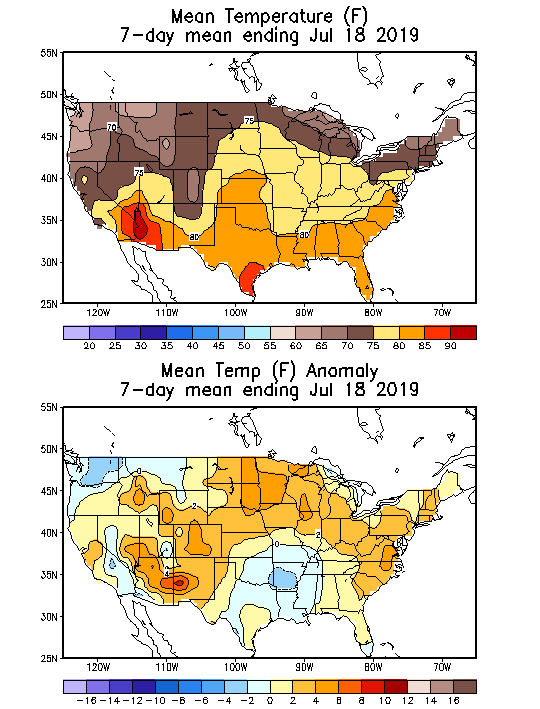
Source: National Oceanic and Atmospheric Administration
Deviation between average and normal (°F)
7-day mean ending Jul 18, 2019

Source: National Oceanic and Atmospheric Administration

